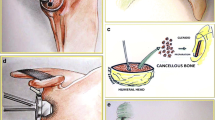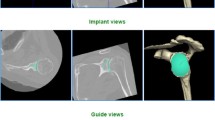Abstract
Purpose
The functional results after reconstruction of the proximal humerus in tumour surgery are poor. Therefore, a reversed proximal humerus replacement was developed in our institution (MUTARS humerus inverse). A low degree of wear on the polyethylene is required because of the patients’ youth and demands on shoulder function. A special type of polyethylene with shock-absorbing properties has been developed to minimise polyethylene wear in the MUTARS inverse proximal humerus replacement. We compared the tribological properties of an anatomical shoulder prosthesis (CAPICA) with the new reversed proximal humerus replacement (MUTARS humerus inverse).
Methods
Both prostheses were tested up to 5 × 106 cycles. Every millionth cycle the surface was inspected and a gravimetric measurement was performed. A measurement of surface roughness was done before testing and after 5 × 106 cycles.
Results
In both prostheses after 5 × 106 cycles there were no major defects, such as delamination, observed. In the reversed proximal humerus replacement abrasion of 28 mg/106 cycles was detected. The mean abrasion of the anatomical prosthesis was 9.28 mg/ 106 cycles.
Conclusion
The glenoid component of the first reversed humerus replacement (MUTARS humerus inverse) has wear properties comparable to those of normal reversed shoulder prostheses. This is important, as this type of prosthesis is used in young patients after resection of bone tumours, with a good functional outcome. It can, therefore, be expected that the revision rate due to wear will be as high as in patients with normal reversed shoulder prostheses.





Similar content being viewed by others
References
Gosheger G, Gebert C, Ahrens H et al (2006) Endoprosthetic reconstruction in 250 patients with sarcoma. Clin Orthop Relat Res 450:164–171
Mittermayer F, Krepler P, Dominkus M et al (2001) Long-term followup of uncemented tumor endoprostheses for the lower extremity. Clin Orthop Relat Res 388:167–177
Sluga M, Windhager R, Lang S et al (1999) Local and systemic control after ablative and limb sparing surgery in patients with osteosarcoma. Clin Orthop Relat Res 358:120–127
Gosheger G, Goetze C, Hardes J et al (2008) The influence of the alloy of megaprostheses on infection rate. J Arthroplasty 23(6):916–920
Hardes J, Ahrens H, Gebert C et al (2007) Lack of toxicological side-effects in silver-coated megaprostheses in humans. Biomaterials 28(18):2869–2875
Hardes J, von Eiff C, Streitbuerger A et al (2010) Reduction of periprosthetic infection with silver-coated megaprostheses in patients with bone sarcoma. J Surg Oncol 101(5):389–395
Gosheger G, Hardes J, Ahrens H et al (2005) Endoprosthetic replacement of the humerus combined with trapezius and latissimus dorsi transfer: a report of three patients. Arch Orthop Trauma Surg 125(1):62–65
Flury MP, Frey P, Goldhahn J et al (2011) Reverse shoulder arthroplasty as a salvage procedure for failed conventional shoulder replacement due to cuff failure–midterm results. Int Orthop 35(1):53–60
Boileau P, Watkinson D, Hatzidakis AM et al (2006) Neer award 2005: the grammont reverse shoulder prosthesis: results in cuff tear arthritis, fracture sequelae, and revision arthroplasty. J Shoulder Elbow Surg 15(5):527–540
Zumstein MA, Pinedo M, Old J et al (2011) Problems, complications, reoperations, and revisions in reverse total shoulder arthroplasty: a systematic review. J Should Elb Surg / Am Shoulder Elb Surg 20(1):146–157
Favard L, Levigne C, Nerot C et al (2011) Reverse prostheses in arthropathies with cuff tear: are survivorship and function maintained over time? Clin Orthop Relat Res 469(9):2469–2475
Farshad M, Gerber C (2010) Reverse total shoulder arthroplasty-from the most to the least common complication. Int Orthop 34(8):1075–1082
Terrier A, Merlini F, Pioletti DP et al (2009) Comparison of polyethylene wear in anatomical and reversed shoulder prostheses. J Bone Joint Surg Br 91(7):977–982
Margevicius KJ, Bauer TW, McMahon JT et al (1994) Isolation and characterization of debris in membranes around total joint prostheses. J Bone Joint Surg Am 76(11):1664–1675
Purdue PE, Koulouvaris P, Potter HG et al (2007) The cellular and molecular biology of periprosthetic osteolysis. Clin Orthop Relat Res 454:251–261
Schmalzried TP, Jasty M, Harris WH (1992) Periprosthetic bone loss in total hip arthroplasty. Polyethylene wear debris and the concept of the effective joint space. J Bone Joint Surg Am 74(6):849–863
Raiss P, Kinkel S, Sauter U et al (2010) Replacement of the proximal humerus with MUTARS tumor endoprostheses. Eur J Surg Oncol 36(4):371–377
Klimkiewicz JJ, Iannotti JP, Rubash HE et al (1998) Aseptic loosening of the humeral component in total shoulder arthroplasty. J Should Elb Surg / Am Shoulder Elb Surg 7(4):422–426
Wirth MA, Agrawal CM, Mabrey JD et al (1999) Isolation and characterization of polyethylene wear debris associated with osteolysis following total shoulder arthroplasty. J Bone Joint Surg Am Vol 81(1):29–37
Braman JP, Falicov A, Boorman R et al (2006) Alterations in surface geometry in retrieved polyethylene glenoid component. J Orthop Res 24(6):1249–1260
Gunther SB, Graham J, Norris TR et al (2002) Retrieved glenoid components: a classification system for surface damage analysis. J Arthroplast 17(1):95–100
Hertel R, Ballmer FT (2003) Observations on retrieved glenoid components. J Arthroplast 18(3):361–366
Scarlat MM, Matsen FA 3rd (2001) Observations on retrieved polyethylene glenoid components. J Arthroplast 16(6):795–801
Matsen FA 3rd, Clinton J, Lynch J et al (2008) Glenoid component failure in total shoulder arthroplasty. J Bone Joint Surg Am Vol 90(4):885–896
Farron A, Terrier A, Buchler P (2006) Risks of loosening of a prosthetic glenoid implanted in retroversion. J Should Elb Surg/ Am Shoulder Elb Surg 15(4):521–526
De Wilde L, Walch G (2006) Humeral prosthetic failure of reversed total shoulder arthroplasty: a report of three cases. J Should Elb Surg / Am Shoulder Elb Surg 15(2):260–264
Author information
Authors and Affiliations
Corresponding author
Rights and permissions
About this article
Cite this article
Dieckmann, R., Liem, D., Gosheger, G. et al. Evaluation of a reconstruction reverse shoulder for tumour surgery and tribological comparision with an anatomical shoulder arthroplasty. International Orthopaedics (SICOT) 37, 451–456 (2013). https://doi.org/10.1007/s00264-012-1771-7
Received:
Accepted:
Published:
Issue Date:
DOI: https://doi.org/10.1007/s00264-012-1771-7




